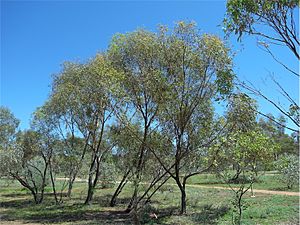Normanton box facts for kids
Quick facts for kids Normanton box |
|
|---|---|
 |
|
| Eucalyptus normantonensis in the Olive Pink Botanic Garden | |
| Scientific classification | |
| Genus: |
Eucalyptus
|
| Species: |
normantonensis
|
| Synonyms | |
|
|
The Normanton box (scientific name: Eucalyptus normantonensis) is a special type of eucalypt. It usually grows as a mallee, which is a shrubby tree with many stems coming from the ground. Sometimes, it can be a small tree. This plant is found only in northern Australia.
The Normanton box has rough bark that can be fibrous or flaky. Its leaves are shaped like a spear or are slightly curved. Its flowers are white and grow in groups of seven to eleven buds. After flowering, it produces woody fruits that look like small barrels or cylinders.
Contents
What the Normanton Box Looks Like
The Normanton box is usually a mallee, growing about 5 to 8 meters (16 to 26 feet) tall. It has a special woody swelling at its base called a lignotuber. This helps the plant regrow after fires.
Its bark is rough and can be fibrous or flaky on some parts of the stems. Higher up, the bark is smooth and brownish. Young plants have leaves that are oval or spear-shaped. These leaves are about 40 to 95 millimeters (1.6 to 3.7 inches) long and 12 to 40 millimeters (0.5 to 1.6 inches) wide. They have a stalk called a petiole.
When the plant is mature, its adult leaves are shiny green on both sides. They are spear-shaped or curved, about 50 to 110 millimeters (2 to 4.3 inches) long and 7 to 20 millimeters (0.3 to 0.8 inches) wide. These leaves also have a petiole, which is about 8 to 22 millimeters (0.3 to 0.9 inches) long.
The flower buds grow at the ends of the branches in groups of seven, nine, or eleven. They are on a small branched stalk called a peduncle, which is 1 to 6 millimeters (0.04 to 0.24 inches) long. Each individual bud has its own tiny stalk, called a pedicel, also 1 to 6 millimeters long.
Mature buds are oval-shaped, about 3 to 4 millimeters (0.12 to 0.16 inches) long and 2 to 3 millimeters (0.08 to 0.12 inches) wide. They have a rounded or blunt cap called an operculum. The Normanton box can flower in most months of the year, and its flowers are white.
After flowering, the plant produces woody fruits. These fruits are called capsules and can be cylindrical, barrel-shaped, or like a flattened sphere. They are about 3 to 5 millimeters (0.12 to 0.20 inches) long and 3 to 4 millimeters (0.12 to 0.16 inches) wide. The parts that open to release seeds are usually below the rim of the fruit.
How the Normanton Box Got Its Name
The Normanton box was officially described in 1919. Two botanists, Joseph Maiden and Richard Hind Cambage, gave it its scientific name. They published their description in a science journal called Journal and Proceedings of the Royal Society of New South Wales.
They found the first samples of this plant near a town called Normanton in Queensland. This is why the plant's specific name, normantonensis, refers to that town. The word "ensis" means "from" or "belonging to."
Where the Normanton Box Lives
The Normanton box is found in different places across northern Australia. You can see it in Western Australia, the Northern Territory, and Queensland.
It grows in areas between the very hot, dry northeastern part of the Gibson Desert and the hot, wet, monsoonal area south of the Gulf of Carpentaria. This plant prefers to grow in open woodlands. You can find it on flat lands, gently rolling hills, and along natural water channels.
How We Protect the Normanton Box
Scientists and governments keep track of how many plants and animals there are. This helps them know if a species is in danger.
The Normanton box is considered "not threatened" by the Western Australian Government's Department of Environment and Conservation (Western Australia). This means it's not currently at risk of disappearing.
It is also classified as "least concern" by the Northern Territory Government under their Territory Parks and Wildlife Conservation Act 1976. The Queensland Government also lists it as "least concern" under their Nature Conservation Act 1992. These classifications mean that the Normanton box is doing well and is not in immediate danger.

